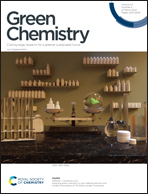Selective catalysis in a cellular microenvironment—a living cell catalytic system with intracellular nanopalladium for olefin hydrogenation†
Abstract
The selectivity of metal nanocatalysts is critical to chemical transformations and industries. Herein, a highly selective heterogeneous living cell catalytic system (LCCS) with intracellular Pd nanodots (bio-nPd) via in situ biomimetic synthesis is constructed. Research studies show that the LCCS is capable of size-selective catalytic hydrogenation for a series of acrylamides in water under mild conditions, and has self-reproducible, reusable and recyclable performance. Moreover, the LCCS also has high catalytic activity: the turnover frequency (TOF) for the acrylamide is up to 198.3 h−1 and the conversion rate is 100%. The calculation results show that the size-selectivity is closely interrelated with the inherent “gating” effect of the cell membrane, which is beneficial for the entry of small molecules. The highly selective and eco-friendly characteristics of the catalytic systems provide an effective strategy for exploring novel catalytic systems that can meet the requirements of sustainable development.



 Please wait while we load your content...
Please wait while we load your content...